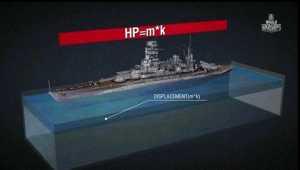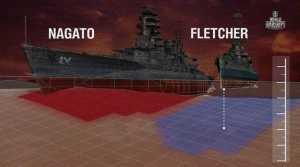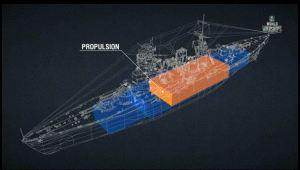Fonte – http://blog.worldofwarships.com/a-ship-through-the-eyes-of-a-game-designer/
Each class has its own characteristics and requires a unique approach. In general terms, the ship can be described by several parameters that strongly affect the gameplay:
- ciascuna classe ha le proprie caratteristiche e richiede un approccio unico e in termini generali la nave può essere descritta attraverso diversi parametri che condizionano pesantemente lo stile di gioco
 Displacement – one of the main parameters that affects the mass of a ship. Displacement is the amount of water displaced by the ship when its underwater part is immersed in water, which is equal to its actual weight. For example, most large ships – batt leships and aircraft carriers – usually have a displacement of 20,000 to 70,000 tons. In the game, this will be reflected as the number of hit points
Displacement – one of the main parameters that affects the mass of a ship. Displacement is the amount of water displaced by the ship when its underwater part is immersed in water, which is equal to its actual weight. For example, most large ships – batt leships and aircraft carriers – usually have a displacement of 20,000 to 70,000 tons. In the game, this will be reflected as the number of hit points
- Dislocamento – uno dei parametri principali. Il dislocamento è l’ammontare di acqua dislocata dalla nave quando la sua parte si trova immersa sott’acqua, che equivale al suo attuale peso. Per esempio, le navi più grandi, corazzate o portaerei, hanno di regola un dislocamento da 20,000 a 70,000 tonnellate. In gioco, questo si rifletterà con il numero di punti vita
Dimensions – represent three quantities: length, width and keel depth of ship. In World of Warships, all of the ship models exactly match the measurements of their real-life counterparts. As a result, you will definitely feel the difference in controlling small, brisk destroyers and large, heavy battleships.
- Dimensioni – ci sono tre dimensioni: lunghezza, larghezza e profondità. In World of Warships le navi corrispondono esattamente alle navi reali. Di conseguenza si sentirà la differenza nel controllare un cacciatorpediniere o corazzate pesanti.
 Keel Depth – the depth of the underwater portion, which affects how close a ship will be able to approach the shore. For example, due to their small keel depth, destroyers are able to sneak through shallow water, evading enemy attacks or launching an ambush from places that other classes can’t access.
Keel Depth – the depth of the underwater portion, which affects how close a ship will be able to approach the shore. For example, due to their small keel depth, destroyers are able to sneak through shallow water, evading enemy attacks or launching an ambush from places that other classes can’t access.
- Profondità della chiglia – la profondità della porzione sott’acqua, che condiziona come la nave riuscirà ad avvicinarsi al porto, alle baie, alle acque basse. Per esempio grazie alla chiglia piccola, i cacciatorpedinieri riusciranno a scivolare attraverso le acque basse, scansando gli attacchi nemici e lanciando imboscate da luoghi inaccessibili ad altre classi.
 Power-Plant Capacity – unlike those in tanks and warplanes, the power plant of a ship is a complex system comprising several steam turbines powered by by a number of boilers. In order to get a huge ship underway, hundreds or even thousands of horsepower are needed. In World of Warships, we have simplified this a bit: we have combined engine and boiler rooms into a single unit called the power plant.
Power-Plant Capacity – unlike those in tanks and warplanes, the power plant of a ship is a complex system comprising several steam turbines powered by by a number of boilers. In order to get a huge ship underway, hundreds or even thousands of horsepower are needed. In World of Warships, we have simplified this a bit: we have combined engine and boiler rooms into a single unit called the power plant.
- Sala macchine – a differenza di carri e aerei, la sala macchine di una nave è un complesso sistema di turbine alimentato da diverse camere. Sono necessari centinaia o anche migliaia di cavalli. In WoWs, tutto è stato semplificato un pò: motori e boiler sono stati uniti in una sola unità: la sala macchine.
Ship Speed -measured in knots (1.852 km/h) or in nautical miles per hour. The fastest ships are the destroyers which are able to achieve speeds up to 40 knots; cruisers average around 35, and low-speed battleships and aircraft carriers move at a speed of 25-28 knots – although some of them can accelerate above 30 knots. Speed is dependent on many factors including the displacement, the size and shape of the ship, and its power-plant capacity.
- Velocità della nave – misurata in nodi (1.852 km/h) o in miglia nautiche per ora. Le navi più veloci sono i cacciatorpedienere che posso raggiungere i 40 nodi, incrociatori 35, corazzate e portaerei 25/28 nodi,, sebbene alcune di loro arrivano a 30, ovviamente la velocità è dipendente da molti fattori come dislocamento, grandezza, forma e sala macchine della nave.